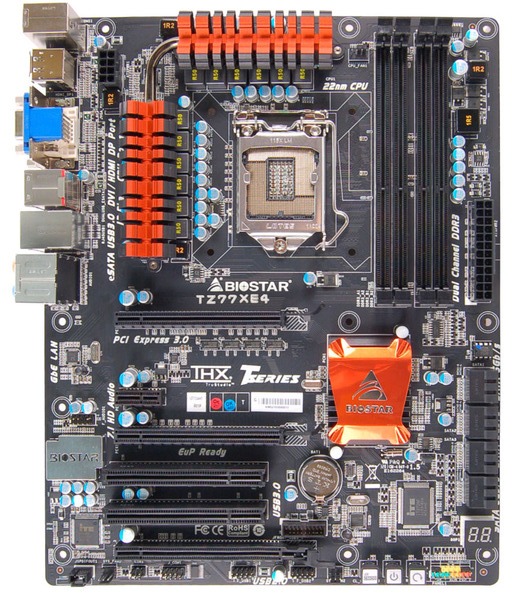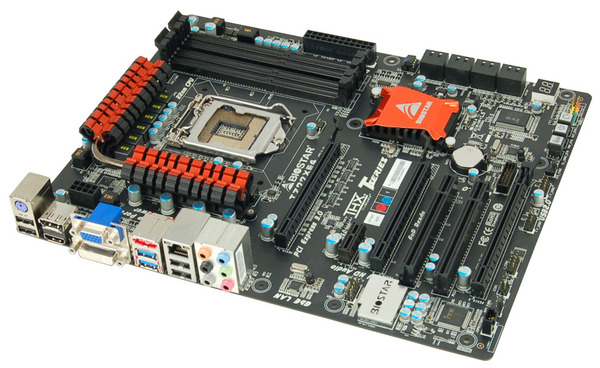Intel Z77 Panther Point Chipset and Motherboard Preview – ASRock, ASUS, Gigabyte, MSI, ECS and Biostar
by Ian Cutress on April 8, 2012 12:00 AM EST- Posted in
- Motherboards
- Intel
- Biostar
- MSI
- Gigabyte
- ASRock
- Asus
- Ivy Bridge
- ECS
- Z77
Biostar TZ77XE4—Visual Inspection
With memories of Biostar fresh in my mind from the 990FX roundup, I have another chance to tackle a motherboard from them. This one comes in at more of a premium than the other—at an MSRP of $169 it is not the cheapest board this time. However, it does seem to have learned some lessons with the PCIe layout at least, but in terms of features we are perhaps a bit lacking.
Biostar have characteristically been black and orange, and we see it here again on their top Z77 model, the TZ77XE4. Power delivery is essentially a 10+2 (CPU/iGPU) system with large brightly colored heatsinks to remove heat, both connected via a heatpipe. These heatsinks are set a little away from the Intel designated socket area, though the memory banks are right up against the boundary—with only two sticks of memory in the board there will be enough room for most of the beefiest air coolers.
In terms of fan headers, Biostar have unfortunately put much effort in here, with only three to play with—a 4-pin CPU fan header to the top right of the socket, and two 3-pin at the south end of the board. Anyone requiring headers for fans will have to resort to providing their own fan control.

Along the right hand side, apart from the 24-pin power connector, we have a series of eight SATA ports—two SATA 6 Gbps from the PCH, four SATA 3 Gbps also from the PCH, and another two SATA 6 Gbps from an ASMedia controller. These are unfortunately not color coded, meaning users will have to double check every time that the SATA cable is going into the port as intended. Below these, we have a two-digit debug display for error reporting.
The chipset heatsink sports the bright orange Biostar color, but is rather small which could lead to it being warm to the touch. On the south side of the board, we are not exactly bursting with headers—aside from the fans, we have front panel headers, a pair of USB 2.0 headers, and power/reset/clear CMOS buttons. These buttons are all similar and next to each other, so I can just see myself accidentally pressing the wrong one from time to time. It is also important to note the location of a USB 3.0 header, just above the third full-length PCIe slot. This is a rather awkward place, and cements its use primarily for rear facing adaptors (as long as there is nothing in the PCI slot beside it).

The PCIe layout is better than previous iterations, featuring an x16 (x8 in dual-GPU), x1, x8, PCI, PCI and Gen 2.0 x4. This leaves a space between GPUs, and a spare x1, PCI and x4 when dual GPUs are being used. Note we do not have a molex connector here, suggesting that Biostar are happy with the power delivery when the PCIe slots are in use.

For back panel functionality, we have a PS2 keyboard port, two USB 2.0 ports (black), DisplayPort, HDMI, D-Sub, DVI-I, eSATA, two USB 3.0 (blue), gigabit Ethernet, two more USB 2.0 (black), and audio jacks. I should stress that even though there is a DVI-I on the back panel, it does not accept analog signals by adaptor.
Board Features
| Biostar TZ77XE4 | |
| Size | ATX |
| CPU Interface | LGA-1155 |
| Chipset | Intel Z77 |
| Power Delivery | 10 + 2 + 1 + 2 (CPU/GPU/VCCIO/Memory) |
| Memory Slots |
Four DDR3 DIMM slots supporting up to 32 GB Up to Dual Channel, 1066-2600 MHz |
| Video Outputs | DisplayPort, HDMI, DVI-D, D-Sub |
| Onboard LAN | Realtek 8111E |
| Onboard Audio | Realtek ALC898 |
| Expansion Slots |
2 x PCIe x16 Gen3 (x16, x8/8) 1 x PCIe x16 Gen2 (x4) 1 x PCIe x1 Gen2 2 x PCI |
| Onboard SATA/RAID |
2 x SATA 6 Gbps (PCH), Support for RAID 0, 1, 5, 10 4 x SATA 3 Gbps (PCH), Support for RAID 0, 1, 5, 10 2 x SATA 6 Gbps (ASMedia Controller) 1 x eSATA 3 Gbps |
| USB |
4 USB 3.0 ports (2 back panel, 2 from headers) 8 USB 2.0 ports (4 back panel, 4 from headers) |
| Onboard |
4 x SATA 6 Gbps 4 x SATA 3 Gbps 1 x USB 3.0 Header 2 x USB 2.0 Header 3 x Fan Headers 1 x CIR Header 1 x SPDIF Output Header 1 x Front Panel Audio Header |
| Power Connectors |
1 x 24-pin ATX connector 1 x 8-pin 12V connector |
| Fan Headers |
1 x CPU Fan Header (4-pin) 2 x SYS Fan Header (3-pin) |
| IO Panel |
1 x PS/2 Keyboard Port 1 x eSATA 2 x USB 3.0 4 x USB 2.0 1 x DisplayPort 1 x HDMI 1 x DVI-D 1 x D-Sub 1 x Gigabit Ethernet Audio Jacks |
| Warranty Period | 3 years from date of sale |
| Product Page | Link |
Aside from the extra SATA controller, PCI slots, Power/Reset buttons and the use of all four display outputs, there's nothing much 'extra' that Biostar have put on the board which isn't already in the default chipset. This could perhaps be their downfall when it comes to conclusions after testing.










145 Comments
View All Comments
Iketh - Sunday, April 8, 2012 - link
I'm curious how Skyrim behaves with this Lucid technology, since physics and framerate are linked for whatever reason... (if you disable Skyrim's 60 fps cap and point the camera in a direction that gives you 150+ FPS for example, everything that is moveable nearby starts to rattle and fall off shelves...)Xale - Sunday, April 8, 2012 - link
Games with their own framerate limits should not be affected, as long as that limit is preserved. They already simply 'pause' internally if the machine is too fast. It might go absolutely crazy though if you do forcefully disable that mechanism.Concillian - Sunday, April 8, 2012 - link
Am I reading that right? Z75 offers most of what even enthusiasts would want?So... why are there a crapton of Z77 boards in here and no Z75s?
Z75 supports 2 way crossfire / SLI, overclocking, 6Gbps SATA, native USB3.0... these are the features all but a tiny handful of users should be interested in.
By all rights Z75 should be the definitive chipset for the average enthusiast. Unless I'm missing something major, I hope there is significant attention paid to the Z75 chipset in reviews, because I'm failing to see why any but the most extreme users and those with money to burn would choose the Z77.
MrSpadge - Sunday, April 8, 2012 - link
Actually the ones with less money to burn might choose Z77 over Z75 to avoid investing in a huge SSD. The difference between chipset prices are usually small (what the motherboard manufacturer makes out of this is another question entirely).GreenEnergy - Sunday, April 8, 2012 - link
I find SSD caching to be some desperate dinosaur attempt. Mainly fueled by HD makers. Hybrid HDs are in the same basket. And yes, pick one, Z77 or Z75. The other one makes no sense.Z77, Z75 and H77 chipsets are priced at US$48, US$40 and US$43.
If SRT basicly cost 8$. Then its time for it to go away as the stillborn tech it is.
Zoomer - Tuesday, April 10, 2012 - link
The difference is mainly software and development, and should go away. SSD caching is a great idea that, imo, should optimally be on the filesystem level, not on the block level.*Looks at OS / filesys developers* (ZFS has some of it)
And oh, I expect lower end derivatives to come out eventually.
Nje - Sunday, April 8, 2012 - link
I was really excited about this motherboard - was kind of disappointed to see it is not part of this roundup. But I guess there will be other tests. Thanks for the preview - I look forward to the benchmarks, particularly if asus' memory technology works well, and if memory bandwidth plays more of a role on Ivy Bridge.Articuno - Sunday, April 8, 2012 - link
Things like overclocking being restricted to specific chipsets is really disappointing. AM3+ boards are generally cheaper than equivalent Intel boards and they don't lock features like this.MrSpadge - Sunday, April 8, 2012 - link
I suppose it's being done to make power delivery cheaper on these boards. Personally I don't like it either.GreenEnergy - Sunday, April 8, 2012 - link
I think you should visit Newegg. LGA1155 and AM3+ boards are just as cheap. And CPU wise...its just a disaster for AMD.